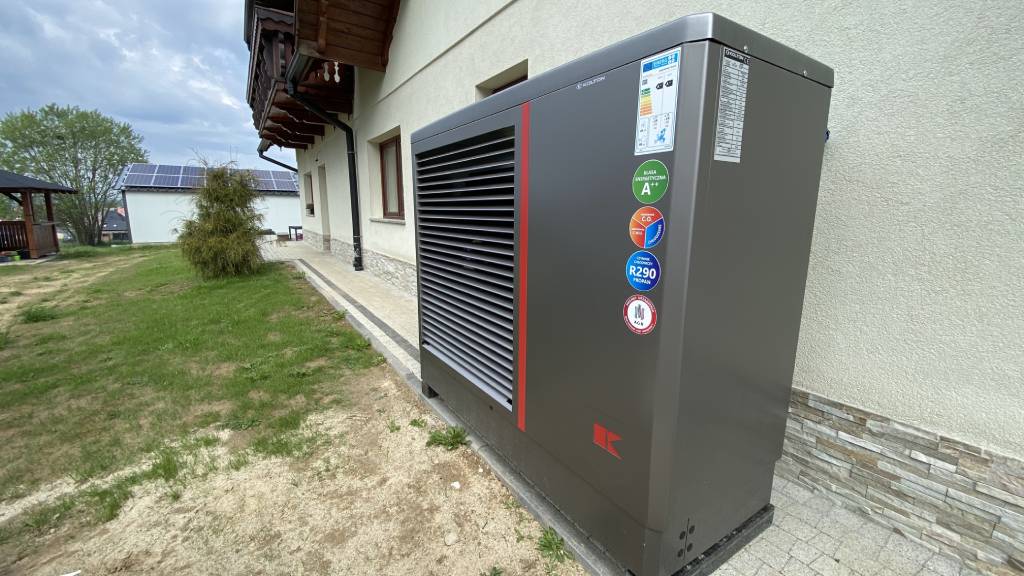Heat pumps
 A heat pump is a type of device that influences the temperature of the room to which it is brought. Our offer includes solutions that were developed together with scientists from AGH in Krakow. The construction of the pumps we offer is distinguished by the design based on the Copeland Scroll compressor on R290. It is an extremely efficient device that ensures maximum heat exchange between the outside air and the working medium.
A heat pump is a type of device that influences the temperature of the room to which it is brought. Our offer includes solutions that were developed together with scientists from AGH in Krakow. The construction of the pumps we offer is distinguished by the design based on the Copeland Scroll compressor on R290. It is an extremely efficient device that ensures maximum heat exchange between the outside air and the working medium.
Future factor
The use of refrigerant in air compressing devices has always been the subject of discussion and research by scientists. Recent studies indicate that the agent known as R290 propane is a factor of the future. All because of the thermodynamic properties used so far. It combines no harmful effects on the environment and excellent cooling performance.
Why is it worth buying a heat pump?
First of all, due to its operating principles:
Thanks to the heat pump, energy from the environment can be converted into heat for the home. For this, the existing heat contained in the water, soil, outdoor air or exhaust air is initially supplied to the refrigerant via a heat exchanger (evaporator). The refrigerant receives this energy via a compressor with a higher temperature level, so it can be used for heating or hot water production via another heat exchanger (condenser).
Depending on the energy source, up to five parts of environmental energy can be obtained for one share of electricity heating energy can be provided. The available ecological energy ranging from -20 ° C to + 35 ° C (air) must be adapted to the temperature level used for heating (hot water). During this process, hot water is "pumped" to an appropriate level at low temperature.
The application of this solution thus contributes to the development of ecology and is environmentally friendly, as it allows the use of mainly natural resources. The benefit for people is certainly the ability to renovate older buildings. With modern heat pumps you can do this in terms of renewable energies. You invest once and use it for years.
 What are the heat pump operating modes:
What are the heat pump operating modes:
1. Monovalent
- In this case, the heat pump is the only heat source in the building. This operating mode is suitable for all low temperature heating systems with a maximum flow temperature of 55 ° C.
2. Mono-energetic
- In this operating mode, the heat pump is supported by an additional electrical heater. This is especially important for air-to-water heat pumps, which provide sufficient heat output at lower outdoor temperatures. During the longest operating periods in the temperature range down to approx. -7 ° C, the heat pump operates as the only heat generator. From an investment and performance point of view, it may be advisable to use additional heating within a few hours below this temperature.
3. Bivalent alternative
- The heat pump supplies all the heating heat up to a certain set outside temperature (e.g. 0 ° C). When the temperature drops below this value, the heat pump stops and heating is provided by the second heat source.
4. Bivalent parallel
- The heat is produced by the heat pump itself up to a certain outside temperature. At lower temperatures, a second heat source is also turned on. If the outdoor temperature drops below the second limit value, the heat pump will stop and the second heat source will provide the full heat source. In contrast to bivalent alternative operation, the share of the heat pump in the annual production is much higher.
Air source heat pump: HPA-O 7 S Premium
An example of a device that uses energy stored in the air is the externally installed HPA-O7 S Premium air to water heat pump, which is used for heating in winter and cooling in summer.
What energy sources do heat pumps use?
1. Air
- However, heat pumps can still draw enough energy to operate in heating mode with an outdoor air temperature of -20 ° C. A special advantage is the simple installation of the air-to-water heat pump as it does not require earthworks or drilling.
2. Water
- Groundwater is a good solar heat buffer. Even on the coldest days, it maintains a constant temperature of + 7 ° C to + 12 ° C.
3. Land
- In our conditions, the ground at a depth of 1.20 m to 1.50 m is warm enough on winter days to use a heat pump in an economical way. Therefore, brine-to-water heat pumps are not subject to performance fluctuations even at sub-zero temperatures. The brine does not freeze and transfers the absorbed heat to the heat pump's evaporator.
Therefore, if you are looking for a company that will professionally help you choose the best heat pump for your home, please contact us!


